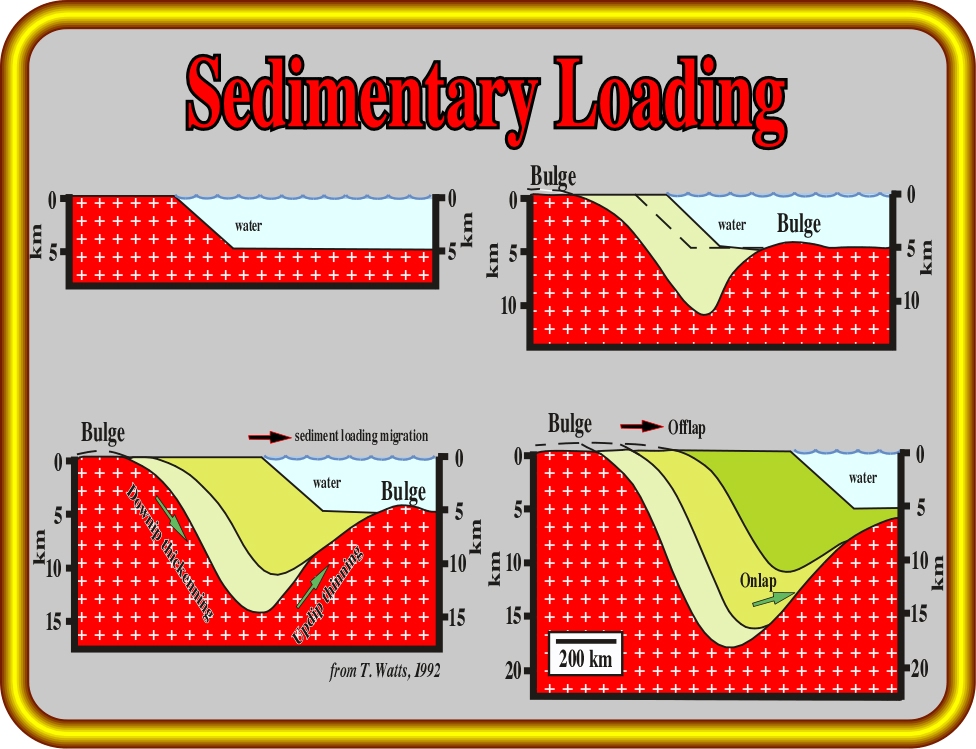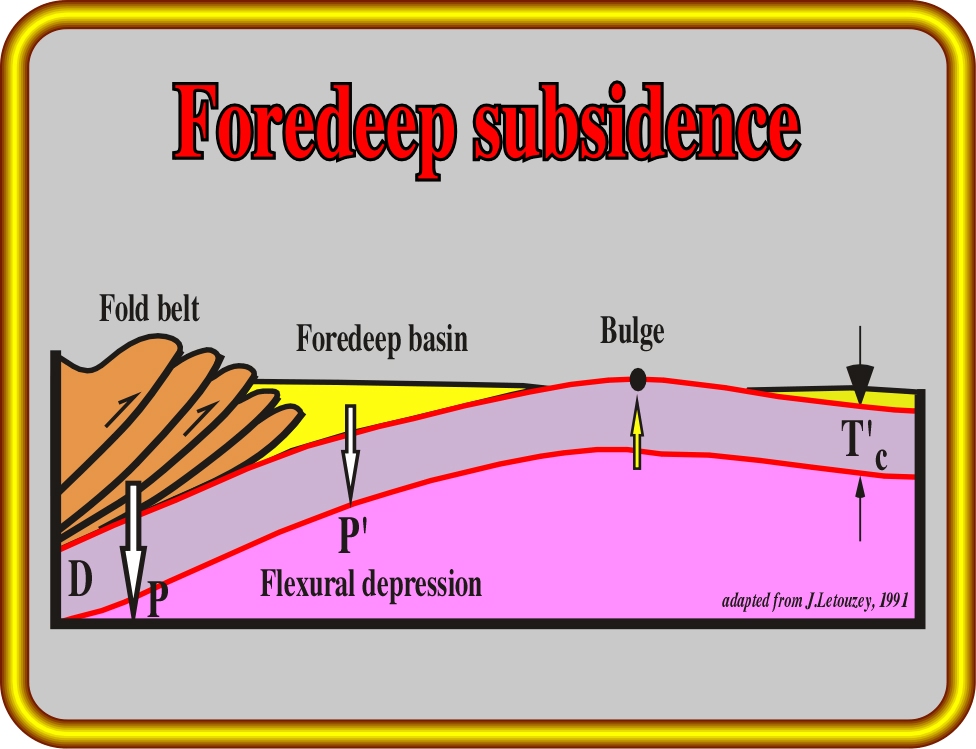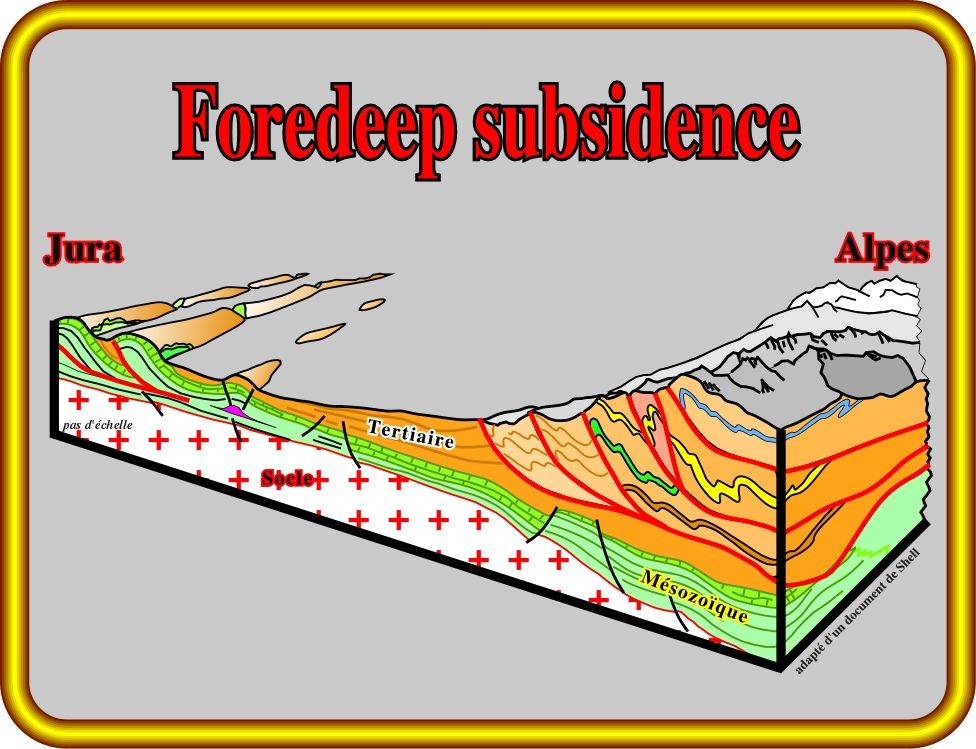
Universidade Fernando Pessoa
Porto, Portugal

Basic Principles in Foredeep & Foldbelt Basins
The principle of isostasy (9) implies the existence in the mantle of a depth of compensation, where pressure, i.e. the force per unit area, on a loaded and unloaded area are equal.
(9) It corresponds to the Archimedes’ principle when applied to a boat, an iceberg, or to a crust floating in a denser mantle.
Since sediments displace water they represent a load on the crust and the lithosphere, (10) which should sag under their weight.
(10) The crust is a chemical layer of the Earth, while the lithosphere is a rheological layer of the Earth. The lithosphere includes the crust (continental or volcanic) and the upper mantle.
Thus, assuming:
Wd - the water depth deposition,
s - the density of the sediments (≈ 2500 kgm-3),
m - the density of the mantle (≈ 3300 kgm-3),
w - the density of the water (≈ 1030 kgm-3),
c - the density of the crust,
Tc - the average thickness of the crust,
r - distance from the base of the crust to the depth compensation,
it is easy to calculate the depth of compensation, where the pressure on a loaded and unloaded column are equal,
Wd . w . g + Tc .
s . g + r .
m . g
and the thickness of sediments
S= Wd [ (m-rw) /(
m -rs )]
In short, if the depth of compensation is localized at the bottom of the crust, theoretically, with a initial water depth of around 2000 m, it is possible to deposit around 5000 m of sediments just due to the subsidence induced by the sedimentary loading.

Fig. 8- These sketches illustrate the sedimentary loading on a passive continental margin: After three successive sedimentary loads, the associated deformations are characterized by (i) a large depression, (ii) a landward and seaward stratigraphic thinning, and (iii) a proximal bulge, often erroneously dubbed flexural bulge and (iv) a distal bulge. Uplift and erosion come together with the proximal bulge.
In other words, if the water depth and the terrigeneous influx are adequate, it is possible to deposit a sedimentary thickness around 2.5 times the water depth without any tectonic subsidence or eustatic change (fig. 8). It is to correct the observed stratigraphic record for the effects of sediment and water loading and changes in water depth that the backstripping technique was introduced.

Fig. 9- Foredeep basins are mechanically driven. Their subsidence is associated with the flexural rigidity (D) which controls the elastic thickness of the underlying lithosphere (T'c), the thrust/fold loading (P), the sedimentary loading of the foredeep itself (P') and the time (T), i.e. relaxation.
As said previously, the subsidence of the foredeep basins is mainly controlled by mechanical rather than thermal geologic events. In the majority of these basins, the loading of the thrust faults of the fold belt induces the subsidence of the substratum. The consequences of this loading, which are enhanced by the sedimentary load, seem to be controlled by the flexural rigidity of the substratum which influences the elastic thickness of the underlying lithosphere (fig. 9).

Fig. 10- The present topography of the Alps cannot explain the subsidence of the Mesozoic sediments which create the space available for the deposition of the foredeep sediments. Several à priori geological hypotheses have been invoked to explain such a subsidence.
The origin of the loading responsible for tectonic subsidence is not always so evident as illustrated on fig. 9. The gravimetric anomalies found in certain fold belts, as in the Himalayas, suggest that the present topography is sufficient to explain the subsidence of the Australian - Indian lithospheric plate. Conversely, in the Alps or Appalachian fold belts gravimetric anomalies suggest that the present topography is insufficient to explain the subsidence of the associated foredeep (fig. 10).
In such a cases, one is obliged to invoke “burial loads” (11) within the crust. However, the temporal distribution of these “burial loads” is practically unknown.
(11) The “burial loads” may correspond to a relic oceanic crust or mantle material thrusting the continental crust emplaced during the convergence of the lithospheric plates.
The recognition and the study of foredeep basins without fold belts associated led certain geologist to think that “burial loads” are responsible by the main mechanism of creation and preservation of foredeep basins. Their geological à priori conjecture is as follows:
"If a fold belt is bring to erosion and if it is responsible for the loading of a foredeep basins, the loading disappears as erosion takes place. Foredeep basins will be partially eroded due to the uplift induced by decreasing of the tectonic loading (weight of the thrusts). Conversely, the burial loads are protected from erosion. Consequently, they will survive a long time within the continental crust".